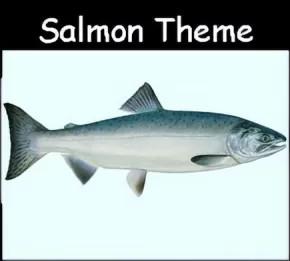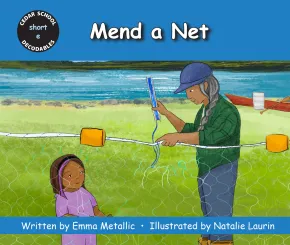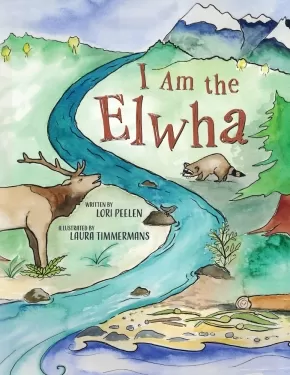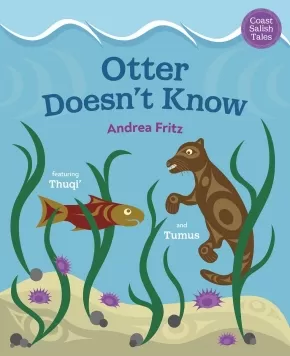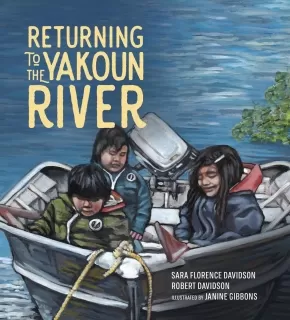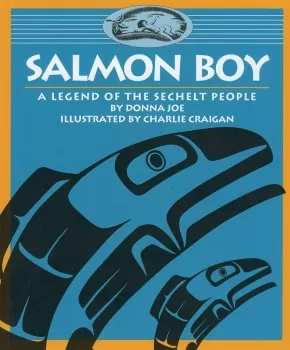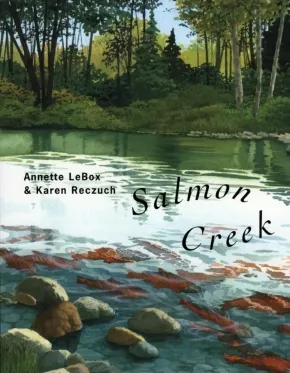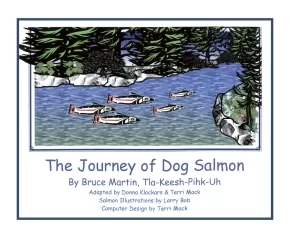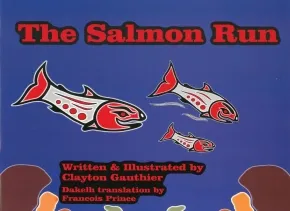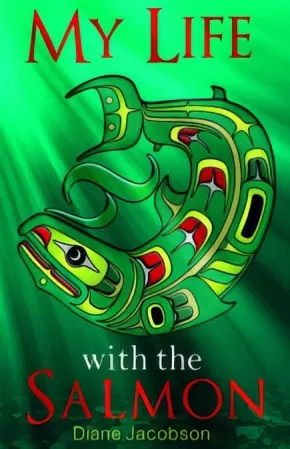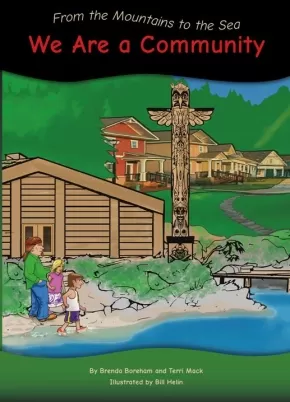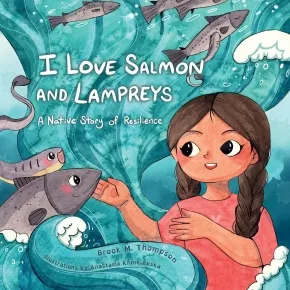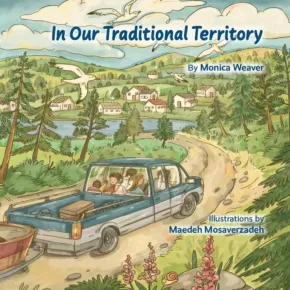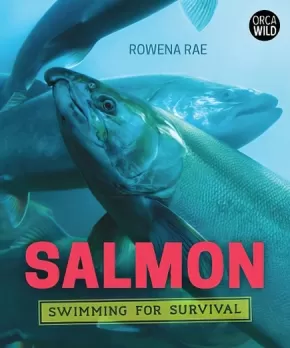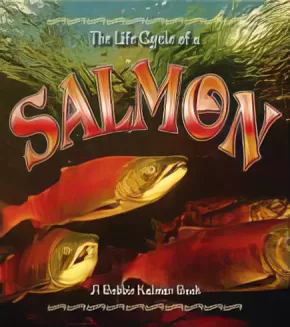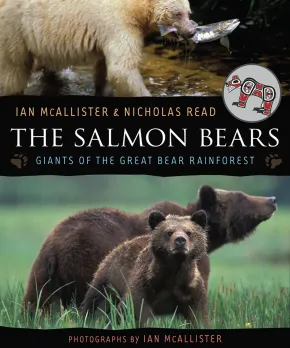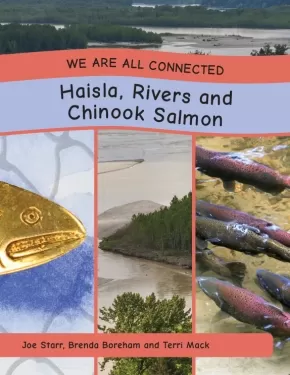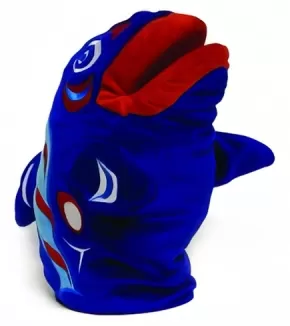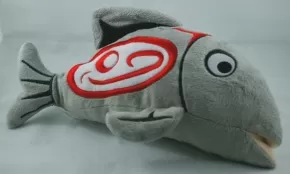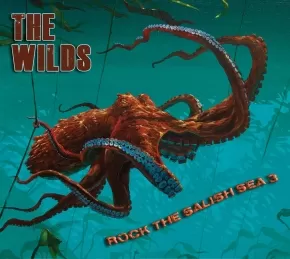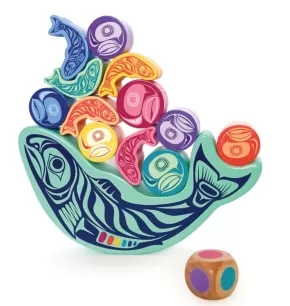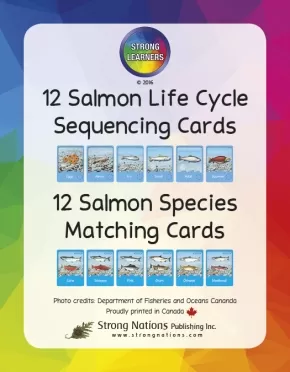
Theme Bundle: Salmon
$488.63
Text Content Territories:
Indigenous American; Alaska Native; Indigenous Canadian; First Nations;
Status: Available
Details:
Strong Nations offers a Salmon Theme Bundle chock-full of resources.
Scroll below to learn more about the Indigenous and supplementary resources included in this bundle. Resource availability may fluctuate.
● The listed materials for this bundle
can be purchased as a full bundle or separately. To purchase the full bundle click on the "Add to
Basket" button above (the first one on this page).
● To purchase items individually, click the "Add to Basket" buttons below, beneath the individual
item titles.
Fiction
A Salmon's Sky View
 $18.50
$18.50

Artists:
Format:
Hardcover
ISBN / Barcode: 9781771744461
Synopsis:
Synopsis:
The ink and watercolour illustrations in this book reflect the life cycle of a salmon from the salmon’s point of view looking up from underwater. Silhouette images provide a clue to the seasons and to the predators the salmon encounters throughout its life. The story reminds us how the salmon demonstrates great determination and strength in its long journey from the stream where life begins, to the ocean, and back to its natal stream.
Carol ends the story with a step-by-step instructional guide to create your own ink and watercolour image.
Educator Information
This is the 10th anniversary edition from CSWA Science in Society award-winning author/illustrator Carol McDougall, B. Ed., M.A. Carol is an international educator and conservationist with decades of classroom and fine arts teaching experience. She conducts workshops on using the arts to help make learning creative and engaging.
Recommended Grades: K-5.
Additional Information
32 pages | 11" x 8.5" | ISBN: 9781771744461 | Hardcover
Cedar School Decodables: Mend a Net
$7.99
Artists:
Format:
Paperback
Text Content Territories:
Indigenous Canadian; First Nations; Mi'kmaq (Mi'gmaq); Listuguj Mi'gmaq First Nation;
Grade Levels: Kindergarten; 1;
ISBN / Barcode: 9781771746397
Synopsis:
Synopsis:
In this story, the class learns how to fish for salmon with a net. But first, Jen must mend the net!
Salmon fishing is important to Mi’gmaq. Mi’gmaq use nets to fish for salmon in large rivers. Traditionally, the inner part of pine trees was used to make and mend nets.
Have you ever seen a fishing net?
Educator Information
Recommended for ages 4-7, for use in kindergarten and Grade 1 classrooms.
Cedar School Decodables is divided into six sets, which increase in word count and complexity of sentence structure. Mend a Net is in Set 1 – Short Vowels, and reviews short e. Books in Set 1 have 40-60 words.
Readers should be familiar with the concepts included in Set 1:
- consonants
- beginning and end blends
- short vowels
- s – /s/ and /z/
- -s suffix
Series Information
Welcome to Cedar School! Join Liv, Tom, Gus, and Bell as they learn on the land and explore Mi’gmaw teachings with their teacher, Miss Sam, and the school’s Mi’gmaw Elder, Jen. With charming illustrations and simple storylines, this decodable series engages students as they practise their reading skills. Each book includes a pre-reading review of non-decodable words, and many of the books introduce special words related to Indigenous teachings. Talking Together prompts facilitate discussions led by the reading teacher.
Developed in partnership with Dyslexia Canada, Cedar School Decodables is a series of 20 decodable books for young readers. Designed for students who have previously learned short vowel and consonant sounds, additional phonic skills are developed progressively throughout the series.
The series will be accompanied by Cedar School Decodables Teacher’s Guide and a series of four picture books, which will be available at a later date.
Additional Information
16 pages | 6.5” x 5.5” | Paperback | ISBN: 9781771746397
I Am the Elwha (HC)
 $18.50
$18.50

Artists:
Format:
Hardcover
Text Content Territories:
Indigenous American; Native American; Salish; Coast Salish; Klallam (Clallam); Lower Elwha Klallam Tribe;
ISBN / Barcode: 9781771744744
Synopsis:
Synopsis:
“I am the Elwha, rushing down to the sea. I am the Elwha, wild and free.”
The Elwha River flows 72 kilometres (45 miles) from its source in the Olympic Mountains to the Strait of Juan de Fuca in the Pacific Northwest. Uniquely, it hosts all six salmon species (Pink, Chinook, Coho, Sockeye, Steelhead, and Chum) as well as several species of trout.
In 1911 two dams were built on the river. The dams blocked the migration routes of the salmon and dramatically altered the entire river ecosystem for 100 years. In 2012 the dams were decommissioned and the world’s largest dam removal and habitat restoration project began.
In this lyrical and beautifully illustrated book, the author chronicles the history of the Elwha. Narrated by the powerful voices of plants and animals that inhabit the river ecosystem, the dam builder, a worker, and the river itself, this story celebrates the ongoing rewilding of this special environment and offers a welcome to all of the creatures who are coming home.
To learn more visit: www.elwha.org
Awards
- 2021 Riverby Award for Young Readers
Reviews
“I Am the Elwha is a powerful read about a powerful river and those who value and protect it." – Raina Delisle, Hakai Magazine
Educator Information
At the back of the book are three pages of cultural, scientific, and historical information that discuss the following:
- the importance and symbolism of salmon to the Lower Elwha Klallam Tribe and other Coastal Salish Tribes
- facts about the six species of salmon found in the Elwha River (Chinook, Pink, Chum, Sockeye, Coho, and Steelhead)
- the history of the Elwha River and its status today
Keywords / Subjects: The Elwha River, Rivers, Dams, History, Environmental Awareness, Lower Elwha Klallam Tribe, Coast Salish, Native American, Culture, Washington, Animals, Salmon, First Salmon Ceremony, Plants, Nature, Settlers, Social Responsibility, Environmental Activism, Poetry.
Recommended for grades 3 to 7.
Additional Information
32 Pages | 8.5" x 11" | ISBN: 9781771744744 | Hardcover
Authenticity Note: This lyrical story, which chronicles the history of the Elwha River, is written by Lori Peelen. Robert Elofson, Tribal Elder and Harvest Manager in the Natural Resources Department for the Lower Elwha Klallam Tribes, approved Lori's work and contributed a few pages of back matter at the end of the work. Lori's story was further approved by Frances Charles, the Tribal Councilwoman for the Lower Elwha Klallam Tribe, after the entire council read and approved it.
The Canadian Content label has been applied because the illustrator of this work is Canadian.
Otter Doesn't Know
$21.95
Artists:
Format:
Hardcover
Text Content Territories:
Indigenous Canadian; First Nations; Salish; Coast Salish; Lyackson ;
ISBN / Barcode: 9781459836211
Synopsis:
Synopsis:
You don't need to have all the answers to be a helper.
Indigenous artist and storyteller Andrea Fritz tells a tale of a salmon and a sea otter who learn it's ok to say "I don't know" and to ask for help.
Thuqi’ the sockeye salmon knows it’s time to spawn, but she is lost in the Salish Sea and doesn't know the way to Sta'lo’, the river. When she asks Tumus the sea otter for help, he doesn’t exactly know either, and he dismisses her questions. But when Tumus becomes lost in some weeds, Thuqi’ shows him that it’s okay not to know something—you can still find a way to help a friend in need.
In this original story set in Coast Salish Traditional Territory, author and artist Andrea Fritz uses Indigenous storytelling techniques and art to share the culture and language of the Hul’q’umi’num’-speaking Peoples.
Educator & Series Information
Recommended for ages 6 to 8.
This book is part of the Coast Salish Tales series.
Themes/Subjects: Nature and Animals; Fish and Marine Life; Courage, Bravery, Hope
Additional Information
32 pages | 8.75" x 10.75" | Hardcover
Returning to the Yakoun River
$21.95
Artists:
Format:
Hardcover
Text Content Territories:
Indigenous Canadian; First Nations; Haida;
ISBN / Barcode: 9781774920213
Synopsis:
Synopsis:
Experience a Haida fish camp through the delighted eyes of children as they learn from the land and from their Elders.
Based on author Sara Florence Davidson’s childhood memories, this illustrated story captures the joy and adventure of a Haida fish camp.
Every summer, a Haida girl and her family travel up the Yakoun River on Haida Gwaii, following the salmon. While their father fishes, the girl and her brother spend their time on the land playing and learning from Tsinii (Grandfather).
Educator & Series Information
Recommended for ages 6 to 8.
This book is part of the Sk'ad'a Stories series.
Additional Information
40 pages | 8.12" x 9.00" | Hardcover
Salmon Boy
$12.95
Artists:
Format:
Paperback
Text Content Territories:
Indigenous Canadian; First Nations; Salish; Coast Salish; Shishalh (Sechelt);
ISBN / Barcode: 9780889711662
Synopsis:
Synopsis:
In Salmon Boy: A Legend of the Sechelt People, a young boy is captured by a Chum salmon and brought to the country of the salmon people-a dry land beneath water where "the salmon people walked about the same as people do above the sea." The boy lived with them for one year, and his captivity becomes a source of learning that will ensure the survival of his own people.
After accompanying the salmon people on their run, the Sechelt boy hops out of the river and returns home to teach everything he has learned to his people who, from that time forward, treat the salmon properly and always have enough to eat. The salmon people, now respected by the humans, happily "give their rich flesh to feed the people of the land."
This beautiful story is accompanied by black and white illustrations of the boy and his adventures. Though written especially for children, Salmon Boy, with its simple message of responsibility and respect, will appeal to all ages.
Educator Information
Simple and compelling First Nations drawings illustrate this dynamic story that teaches respect for the environment and describes the life cycle of the salmon.
Series Information
This book is part of the Legends of the Sechelt Nation series.
Additional Information
24 pages | 7.00" x 8.50"
Salmon Creek
$14.95
Artists:
Format:
Paperback
ISBN / Barcode: 9780888996442
Synopsis:
Synopsis:
One of the most fascinating stories in nature is the life cycle of the Pacific salmon. This lyrical, beautiful picture book tells the story of one coho, Sumi, from her birth in a remote creek, to her final hours when she spawns and then dies.
All the phases of Sumi's life are shown, from her trip down river to the ocean, her time as a fully mature fish swimming in the great seas, to the most fascinating and mysterious period in the life cycle of these magic animals - the determined return to her birthplace.
Many thousands of people come to witness these last moving moments in the lives of salmon. As wild salmon become rarer due to our exploitation of their environment and the consequent destruction of their habitat, as well as our abusive overfishing practices, their story engages us more than ever. This book is a plea for the protection of salmon and of the natural world they inhabit. An afterword presents the factual basis for the book and amplifies on the poetic text.
Reviews
"Reczuch, Karen's sumptuous, detailed paintings complement the text to create an informative resource useful for explaining the remarkable natural phenomenon of salmon migration." — Green Teacher
"Salmon Creek is one of those rare information picture books which proves equally engaging to young listeners and older independent readers. (To say nothing of adult readers who can't help but savor the poetic text and breathtaking illustrations.)" — Canadian Materials, October 2002
Additional Information
48 pages | 9.00" x 10.90" | Paperback
Strong Stories Tlingit: Gift of the Salmon
 $9.95
$9.95

Artists:
Format:
Paperback
Text Content Territories:
Indigenous American; Alaska Native; Tlingit; Indigenous Canadian; First Nations; Tlingit;
ISBN / Barcode: 9781771741088
Synopsis:
Synopsis:
As Raven flew over the forest, some of the salmonberries that he was carrying in his beak fell into the river. The berries washed out into the ocean where, “They grew and they grew until each sprouted a tail. Then two eyes and a mouth, both male and female.”
Bill Helin’s lyrical text and engaging illustrations will delight readers of all ages with this story about the origin of the salmon and its food chain and life cycle.
Educator & Series Information
Gift of the Salmon is part of the Strong Stories: Tlingit series. Strong Stories focus on different First Nation territories from across Canada and the United States. These stories reflect the belief that our stories are the roots of our people, our lands and our cultures. It is from our stories that we grow and become strong and proud.
This resource is also available in French: Le Don du saumon.
Additional Information
16 pages | 6.00" x 9.00" | ISBN: 9781771741088
The Journey of Dog Salmon
 $11.50
$11.50

Artists:
Format:
Paperback
Text Content Territories:
Indigenous Canadian; First Nations; Nuu-chah-nulth (Nootka); Tla-o-qui-aht First Nation;
ISBN / Barcode: 9780987967008
Synopsis:
Synopsis:
Dog Salmon is the bully of the river and is taught how important it is to respect others. The story also integrates the natural salmon cycle.
Additional Information
18 Pages | 8.5" x 7" | Paperback | ISBN: 9780987967008
The Salmon Run
$10.95
Artists:
Format:
Paperback
Text Content Territories:
Indigenous Canadian; First Nations; Dene; Dakelh (Carrier);
ISBN / Barcode: 9781926886442
Synopsis:
Synopsis:
“The Salmon Run”, follows a salmon on his journey to return to the spawning grounds. Written and illustrated by Clayton Gauthier, the debut book of talented artist and storyteller.
Additional Information
Dakelh translation by Francois Prince.
Novel
My Life with the Salmon (1 in stock, Out of Print)
$18.95
Format:
Paperback
Text Content Territories:
Indigenous Canadian; First Nations; Kwakwaka'wakw (Kwakiutl); Namgis;
ISBN / Barcode: 9781894778886
Synopsis:
Synopsis:
Diane “Honey” Jacobson’s latest book is an important comment about First Nations efforts to save the salmon and her personal youthful journey to find meaning and a sense of place in life. Like the style in her first book My Life in a Kwagu’l Big House, Diane’s style in My Life with the Salmon is full of action, amazing adventures and fascinating connections between land, water and people. In My Life with the Salmon, we follow “Honey” through sometimes hilarious and sometimes difficult periods but we always learn a life lesson.
Awards
- 2012 Winner of the Independent Publisher Book Awards
Additional Information
176 pages | 5.50" x 8.47"
Non Fiction
From the Mountains to the Sea: We Are a Community
 $29.95
$29.95

Artists:
Format:
Paperback
Text Content Territories:
Indigenous Canadian;
Grade Levels: 2;
ISBN / Barcode: 9781771741033
Synopsis:
Synopsis:
Each book in the series, From the Mountains to the Sea, supports the new BC Aboriginal Learning Standards in both Science and Social Studies.
Click link to download a Grade 2 five-week planning guide: Grade 2 FREE Download for We Are a Community
Back of book introduction:
From the Mountains to the Sea: We Are a Community is a Grade 2 resource, which covers all of your Aboriginal Learning Standards in both science and social studies within the new BC curriculum.
This book is about a river. Most rivers start high up in the mountains. As the water comes downhill, it makes little pathways in the rocks and gravel. As the pathways get bigger, they join to make streams. When several streams join, they make a river. Some rivers have waterfalls and deep pools. In some places, fast moving water tumbles over rocks forming rapids. When a river leaves the mountain for flatter ground it starts to slow down. Eventually, a river ends when it flows into the sea. Where the fresh water and the salt water meet is an estuary. Have you ever been to an estuary?
The area in and around an estuary is a good place for plants, animals and people to live because we can all find food and water there. The salmon is an important food for many of us. Have you ever eaten salmon?
People have paid attention to the life cycle of salmon for thousands of years. We have learned that sometimes we can help salmon survive by building a salmon hatchery along a river. Some hatcheries are huge while others are quite small. Have you ever visited a salmon hatchery?
There are many sizes of rivers in the world. Some are wide. Some are narrow. Some are deep. Some are shallow. Do you live near a river? What plants and animals have you seen there?
This book is also part of a bundled package that includes:
- a card game: matching and sequencing
- a CD
- bulletin board trimmers
Click here to view the bundle: From the Mountains to the Sea: We Are a Community Bundle
This resource is available in French: Collection Des montagnes à la mer: Nous sommes une communauté
Additional Information
Book dimensions: 10" x 14" | Pages: 16 | ISBN: 9781771741033
I Love Salmon and Lampreys: A Native Story of Resilience
$30.95
Artists:
Format:
Hardcover
Text Content Territories:
Indigenous American; Native American; Karuk; Yurok;
ISBN / Barcode: 9781597146685
Synopsis:
Synopsis:
For young readers, an inspiring story about a river, a successful Native-led movement for environmental justice, and the making of a scientist.
Growing up in the Yurok and Karuk Tribes, Brook Thompson learned to care for the fish that nurtured her and her family. She knew that along the Klamath River in Northern California, salmon and lampreys are a needed part of life. But she also saw how these fish were in danger. People had built dams along the Klamath River, making it very hard for salmon and lampreys to live. Tribal people and their friends organized to have four of the dams removed, and they won. In I Love Salmon and Lampreys, Thompson tells this inspiring tale, and she shares how it motivated her to become a scientist. Featuring adorable illustrations by Anastasia Khmelevska, as well as fun facts about salmon and lampreys, this is a stirring story about stewarding nature for the generations to come.
Reviews
"[Brook Thompson] compares these salmon transitions to her own life, sharing how she left her family to go out to university to learn how to protect salmon and lampreys and then came home to fight for conservation rights as an engineer and scientist. Maps, back matter, and fun facts enhance this satisfying, engaging story." —Booklist
"A powerful story about protesting for positive changes that protect the environment." —Kids Bookshelf
"The book not only celebrates the resilience of the Klamath River and its inhabitants but also highlights the profound impact of environmental justice on the lives of individuals and communities. It is a powerful reminder that we all have a role to play in protecting our planet and ensuring a healthy future for generations to come." —Mama Likes This
Educator Information
Recommended for ages 4 to 8.
Additional Information
32 pages | 9.00" x 9.00" | Hardcover
In Our Traditional Territory
$16.95
Artists:
Format:
Paperback
Text Content Territories:
Indigenous Canadian; First Nations; Dene; Dakelh (Carrier); Lake Babine Nation ;
ISBN / Barcode: 9781777894719
Synopsis:
Synopsis:
On the river, beaver smacks his tail, the salmon swim, and a family pull in the catch. As a member of her community, six-year-old Monica participates in the traditional salmon harvest among the picturesque scenery, cold mornings, warm fires, and extended family.
Educator Information
Recommended for kindergarten to grade 3.
This book is available in French: Dans Notre Territoire Traditionnel.
Additional Information
36 pages | 8.25" x 8.25" | Paperback
Salmon: Swimming for Survival
$24.95
Format:
Hardcover
Text Content Territories:
Indigenous;
ISBN / Barcode: 9781459826533
Synopsis:
Synopsis:
Salmon: Swimming for Survival introduces us to the dramatic life story of salmon.
These fish hatch in streams, swim extreme distances out to sea, and then migrate home to where they were born to produce the next generation. But today their habitats and very survival are threatened by human activity. This book looks at the unique biology of salmon, their importance to many Indigenous communities, their cultural and economic impact and the vital role they play in ecosystems. With profiles from scientists, educators, fishers and more, learn about the people who are working hard to change the uncertain future of salmon and improve the chance that these iconic fish can survive for generations to come.
Reviews
“A wealth of good, up-to-date information...This comprehensive book has a great deal to offer to help everyone understand the critical nature of salmon conservation. Highly Recommended.” — CM: Canadian Review of Materials
“This informative book...takes a complex subject and breaks it down into parts that are easy to comprehend. Recommended.” — School Library Connection
Educator & Series Information
This book is part of the Orca Wild series that examines the intricacies of animals, ecosystems, humans and our relationships to each other.
Recommended for ages 9 to 12.
Includes some Indigenous content.
Additional Information
112 pages | 7.50" x 9.00" | Hardcover
The Life Cycle Of A Salmon
$10.95
Format:
Paperback
ISBN / Barcode: 9780778707059
Synopsis:
Synopsis:
The Life Cycle of a Salmon looks at the growth of a salmon from egg to adult, and provides children with a thorough account of the five distinct stages of a salmon's life cycle: egg, alevin, fry, smolt, and adult.
Additional Information
32 pages | 8.50" x 9.50"
The Salmon Bears: Giants of the Great Bear Rainforest
$19.95
Artists:
Format:
Paperback
Text Content Territories:
Indigenous Canadian; First Nations;
ISBN / Barcode: 9781554692057
Synopsis:
Synopsis:
Extensively illustrated with Ian McAllister's magnificent photographs, The Salmon Bears explores the delicate balance that exists between the grizzly, black and spirit bears and their natural environment, the last great wilderness along the central coast of British Columbia.
Key to this relationship are the salmon that are born in the rivers each spring, who then go out to sea as juveniles and return as adults to spawn and die, completing a cycle of life that ensures the survival of not only their own species but also virtually every other plant and animal in the rainforest.
In clear language suitable for young readers, the authors describe the day-to-day activities that define the lives of these bears through the four seasons. But this is also very much the story of the Great Bear Rainforest—a vast tract of land that stretches from the northern tip of Vancouver Island to the Alaska border and contains some of the largest stands of old-growth forest left on the West Coast. The Salmon Bears focuses on the interconnectedness of all life in the rainforest and makes a strong case for the importance of protecting this vital ecological resource.
Additional Information
90 pages | 7.50" x 9.00"
The Sockeye Mother
$23.00
Artists:
Format:
Hardcover
Text Content Territories:
Indigenous Canadian; First Nations; Gitxsan (Gitksan);
ISBN / Barcode: 9781553797395
Synopsis:
Synopsis:
To the Gitxsan people of Northwestern British Columbia, the sockeye salmon is more than just a source of food. Over its life cycle, it nourishes the very land and forests that the Skeena River runs through and where the Gitxsan make their home. The Sockeye Mother explores how the animals, water, soil, and seasons are all intertwined.
1 SMALL FRY
There’s a strong undertow today. The turbulent waters caress the backs of the little semelparous life forms emerging from their gravel nests. A small free-swimming fry bears witness to the currents of spring, after spending weeks developing and using up its nutritious yolk sack. It’s one of few remaining fry leaving its long winter’s home to seek out nursing waters.
This is the time of Wihlaxs (the black bear’s walking moon), which is early spring to the Gitxsan peoples of the Pacific Northwest Interior. Change is in the air, the days grow longer, and renewal is the life force that guides the world around the little fry’s waterways. Flora cells are starting to stir, preparing to bud and bring green to the landscape. Stores of food for the people along Xsan (river of mists) is running low, but preparations for the new seasons of fishing and gathering have begun. New snow falls to take away the old snow, which the Gitxsan call dalugwa.
Miso’o, or sockeye, are one of many species of salmon that call Xsan home. Although all species are valued, the Gitxsan prefer the flavour and number of Sockeye that return to their spawning grounds every year. The cultures along Xsan, otherwise known as the Skeena River, flourished and shaped their existence around the life cycles of this keystone species. Little does this small sockeye fry know that its life cycle not only nourishes the people and other beings along the watersheds, it is the whole reason the forests and landscapes exist.
2 TIME TO GROW
After a couple of years of “schooling” in the deeper parts of the nursing lake, this sockeye has become a smolt. Its little silvery body begins taking the shape of its blue-backed future self. The smolt is outgrowing the lake, and this signals Lasa ya’a (the spring salmon’s returning moon), so the little sockeye begins its treacherous journey down the Skeena.
As the spring salmons return, the sockeye smolts depart to relieve their urge for saliferous waters. April carries summer innuendos, as warm winds flow through nearly blooming flowers. The scent of pines and cedar waft across moist pillowy moss. The nets and rods of the Gitxsan people scour Xsan in hopes of taking part in the return of ya’a, the spring salmon. Ceremony is held and feasts occur to welcome the runs of salmon who come to replenish the land. It’s not only a time to give thanks, but also a time to send prayer that the salmon will always return, that they will provide nourishment for all that is living within its realm.
The young sockeye has so far avoided predation, dodged the unnaturally changing landscape denuding from the clear-cutting of man, and escaped the hungry hands of ’watxs, the otter. The smolt and her school have made their journey to the Pacific, and north to the ocean waters, where they will continue to feed and grow.
3 A REPLENISHING DEATH
For two years the sockeye mother has been feeding in the ocean waters, while avoiding sharks and killer whales. Through instinct, smell and much that is still not understood, the sockeye mother swims against the powerful currents of Xsan to return to the exact place in the rivers where she was spawned.
It’s now Lasa lik’i’nxsw (the grizzly bear’s moon). August is the time when all the Gitxsan people and grizzly bears pluck hundreds of thousands of sockeye from the Skeena. Many predators such as the grizzly discard most of the carcass. They carry their catch sometimes hundreds of metres into the forest, only to eat the fatty bellies and eggs. The decaying bodies of the salmon leaves nitrogen that nourishes the soil.
Battered and beaten by the journey, she is literally decaying due to lack of food and constant hard work. She finds a male partner who’s dug a nest to her liking. She lays her eggs. She can now die a replenishing death. The dying salmon bodies become fertilizer for all the flora that shape the great lands. Without the sockeye mother, the Gitxsan as they are, would simply not exist.
Awards
- The Science Writers and Communicators of Canada Award, Youth Category.
- McNally Robinson Book for Young People Award
Educator & Series Information
Recommended for Grades 4-7 for theses subject areas: Science, Social Studies.
This book is part of the Mother of Xsan series, which uses striking illustration and lyrical language to bring the poetry of the Xsan ecosystem to life.
Additional Information
| 32 pages | 6.50" x 10.00" |
We Are All Connected: Haisla, Rivers and Chinook Salmon
 $21.95
$21.95

Format:
Paperback
Text Content Territories:
Indigenous Canadian; First Nations; Haisla (Kitamaat);
ISBN / Barcode: 9781771742467
Synopsis:
Synopsis:
“We Are All Connected” is a series that explores how we all live together in a shared balance upon Mother Earth. Each book explores a specific ecosystem with a focus on one animal and its adaptations for survival within that ecosystem. Indigenous interviewees, each living within the same area, have responded to strategic questions as to how their community interacts with the land, their traditional territory. Explore each text with a sense of inquiry in mind.
8 We Are All Connected Titles Coast Salish, Coastal Rainforests and Cougars Haisla, Rivers and Chinook Salmon Inuit, Tundra and Ravens Lakota, Mixed Grasslands and Bald Eagles Métis, Wetlands and Mallards Nisga'a, Ponds and Leopard Frogs Nlaka'pamux, Grasslands and Rattlesnakes Sto:lo, Riparian Forests and Black Bears Each title covers the following curricular areas. Traditional storytelling and artwork begin each title from the focus Indigenous territory. Science: Biodiversity, classification, life cycles, food chains, food webs and connections between living and non-living things are just some of the science concepts included in each book. Social Studies: Contemporary and historical Indigenous cultural knowledge flows throughout each book. Local land forms, gatherings, harvesting practices and government are some of the social studies concepts included in each book.
2 Foundation Titles The two foundational books provide deeper understanding of the content of the “We Are All Connected” titles. We Are All Connected: The Earth, Our Home- explores biomes, ecosystems and biodiversity. We Are All Connected: The Earth, We Share- explores the interconnectedness between living and non-living things.
Authenticity Note: There is some Indigenous art in this book, such as a pendant carved by a Haida artist.
Additional Information
32 pages | 8.50" x 11.00" | ISBN: 9781771742467
Plush and Puppets
First Nations Finger Puppet: Bill Helin - Salmon
$8.50
Artists:
Size:
5 inches
Synopsis:
Salmon Finger Puppet with First Nations Designs by Bill Helin
Length: Approx 5"
First Nations Hand Puppet: Streamer the Salmon
$28.50
Artists:
Size:
26 cm H
ISBN / Barcode: n/a
Synopsis:
Synopsis:
Designed by Eric Parnell, Haida.
Approximately 10"
High quality stuffed animal, all new material.
First Nations Plush: Bill Helin - Sammy the Salmon
$15.95
Artists:
Size:
30 cm L
ISBN / Barcode: 689137128803
Synopsis:
Synopsis:
Salmon Plush with First Nations designs by Bill Helin
Length: Approx 12"
Learning Environment
Bulletin Board Trimmer: Salmon
 $18.95
$18.95

Artists:
Size:
89cm L X 7 cm W
ISBN / Barcode: 459312859019
Synopsis:
Synopsis:
Beautiful salmon designs by Tsimshian artist Bill Helin.
15 pieces cover nearly 44 feet around your bulletin board.
Each piece is 35" x 2.75".
Additional Information
ISBN: 459312859019
CD: Rock the Salish Sea
$20.00
Artists:
ISBN / Barcode: 830159018607
Synopsis:
Synopsis:
This CD includes 15 songs about the Salish Sea.
When listening or singing to this CD, think about the Salish Sea Marine Survival Project: a massive scientific undertaking to research why runs of Chinook, Coho and Steelhead have decreased to one-tenth of past peak levels over the past 20 years in the Salish Sea. The Project involves more than 150 scientists and technical staff from more than 40 federal and state agencies, First Nations, universities, industry and non-profit organizations from Canada and the United States. The coordination is being conducted by two non-profits: the Seattle-based Long Live The Kings and the Vancouver-based Pacific Salmon Foundation.
Find out more here: marinesurvivalproject.com
Stacking Blocks & Balancing Game: Paul Windsor - Salmon and Eggs
$34.99
Artists:
Size:
8.58 inches x 7.28 inches x 1.50 inches
ISBN / Barcode: BALG102
Synopsis:
Synopsis:
Stacking Blocks & Balancing Games enhance children's hand-eye coordination, and also serve as a great educational tool for children to learn about colours and shapes. The perfect gift for kids and family!
Additional Information
- Measurements: 8.58" x 7.28 " x 1.50"
- Materials: MDF Wood
- Packaging: One set includes 1 big salmon, 5 small salmon, 7 circular eggs, and 1" dice
- Motif: Salmon
- For ages 4 and up
Strong Learners Memory Matching and Life Cycle Cards: Salmon
 $14.95
$14.95

Size:
4.5 inches x 3.5 inches
ISBN / Barcode: 459312860015
Synopsis:
Synopsis:
This card game provides two learning opportunities. Cards consist of six salmon species and the six life cycle stages of the salmon and a salmon crest image. On the salmon species cards students will see both the marine and spawning phase of the salmon on one card.
25 Cards – 1 Instructional Card and 2 each of the following:
• Eggs
• Fry
• Alevin
• Smolt
• Adult
• Spawner
• Chinook
• Chum
• Coho
• Pink
• Sockeye
• Steelhead
Educator Information
At Strong Nations, we strive to provide meaningful learning opportunities for all learners with our products. These cards support the book From the Mountains to the Sea: We Are a Community.
Find Salmon Memory Matching Cards in French HERE!
Card Game Creator: Terri Mack
Additional Information
25 cards per set | 4.5" x 3.5" | ISBN: 459312860015

 Go
Back
Go
Back